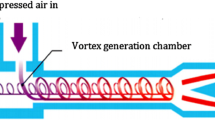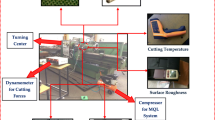Abstract
Nickel-based super alloys are widely employed in critical applications, mainly in aerospace, marine, and chemical industries, concerning the production of high-performance artifacts. These alloys are considered as hard-to-cut materials, because of their modest machinability, so it is very difficult to implement in an industrial context high-speed machining processes that can lead to higher quality products, with improved mechanical characteristics and higher dimensional accuracy, and increase productivity. Among these alloys stands out Waspaloy, thanks to its very high mechanical properties, such as stiffness and strength to weight ratio. In order to implement effective machining processes, it is important to analyze the behavior of the material during machining in terms of variables of industrial interest (forces, tool wear, etc.). The aim of this paper is to disclose the results of an experimental investigation aimed to determine the effects of different cutting parameters on cutting forces, chip morphology, tool wear, and temperature at tool-chip interface, during orthogonal machining of Waspaloy (45 HRC). Experiments were performed in different lubri-cooling conditions (dry, wet, and cryogenic) and at varying cutting conditions (cutting speed and feed rate).
Similar content being viewed by others
References
Thakur A, Gangopadhyay S (2016) State-of-the-art in surface integrity in machining of nickel-based super alloys. Int J Mach Tool Manu 100:25–54
Ezugwu EO, Bonney J, Yamane Y (2003) An overview of the machinability of aero-engine alloys. J Mater Process Technol 134:233–253
Del Prete A, Primo T, Franchi R (2013) Super-nickel orthogonal turning operations optimization. Elsevier Publication Procedia CIRP, Volume 8, pp 163–168
Del Prete A, De Vitis A, Filice L, Caruso S, Umbrello D (2012) Tool engage investigation in nickel superalloy turning operations. Key Eng Mater 504–506:1305–1310
Del Prete A, De Vitis A, Anglani A (2010) Roughness improvement in machining operations through coupled metamodel and genetic algorithm technique. 1nt J Mater Form
Devillez A, Schneider F, Dominiak S, Dudzinski D, Barrouquere D (2007) Cutting forces and wear in dry machining of Inconel 718 with coated carbide tools. Wear 262:931–942
Cheng K (2009) Machining Dynamics, Fundamentals, Applications and Practices. Springer-Verlag London pp 17–19
Altintas Y (2012) Manufacturing automation: metal cutting mechanics, machine tool vibrations, and CNC design. 2nd Edition, Cambridge University Press pp 60–64
Ulutan D, Ozel T (2011) Machining induced surface integrity in titanium and nickel alloys: a review. Int J Mach Tool Manu 51:250–280
Zhu D, Zhang X, Ding H (2013) Tool wear characteristics in machining of nickel-based superalloys. Int J Mach Tool Manu 64:60–77
Cantero JL, Dìaz-Àlvarez J, Miguélez MH, Marìn NC (2013) Analysis of tool wear patterns in finishing turning of Inconel 718. Wear 297:885–894
Khan SA, Soo SL, Aspinwall DK, Sage C, Harden P, Fleming M, White A, M’Saoubi R (2012) Tool wear/life evaluation when finish turning Inconel 718 using PCBN tooling. Procedia CIRP 1:283–288
Del Prete A, De Vitis A, Franchi R (2012) Numerical-experimental correlation of distortions induced by machining process on thin-walled nickel super alloy forged components. Key Eng Mater 504-506:1299–1304
Thakur A, Gangopadhyay S (2016) Dry machining of nickel-based super alloy as a sustainable alternative using TiN/TiAlN coated tool. J Clean Prod 129:256–268
Ding H, Shin YC (2013) Improvement of machinability of Waspaloy via laser-assisted machining. Int J Adv Manuf Technol 64:475–486
Kaynak Y (2014) Evaluation of machining performance in cryogenic machining of Inconel 718 and comparison with dry and MQL machining. Int J Adv Manuf Technol 72:919–933
Pusavec F, Deshpande A, Yang S, M’Saoubi R, Kopac J, Dillon OWJ, Jawahir IS (2014) Sustainable machining of high temperature nickel alloy e Inconel 718: part 1—predictive performance models. J Clean Prod 81:255–269
Pusavec F, Deshpande A, Yang S, M’Saoubi R, Kopac J, Dillon OWJ, Jawahir IS (2014) Sustainable machining of high temperature nickel alloy e Inconel 718: part 2—chip breakability and optimization. J Clean Prod 87:941–952
Ezugwu EO (2005) Key improvements in the machining of difficult-to-cut aerospace superalloys. Int J Mach Tool Manu 45:1353–1367
Jawahir IS, Attia H, Biermann D, Duflou J, Klocke F, Meyer D, Newman ST, Pusavec F, Putz M, Rech J, Schulze V, Umbrello D (2016) Cryogenic manufacturing processes. CIRP Ann Manuf Technol 65:713–736
Olovsjö S, Nyborg L (2012) Influence of microstructure on wear behavior of uncoated WC tools in turning of Alloy 718 and Waspaloy. Wear 282–283
Reed RC (2006) The superalloys. Cambridge University press, Cambridge
Pusavec F, Kopac J (2011) Sustainability assessment: cryogenic machining of Inconel 718. J Mech Eng 57:637–647
Umbrello D, Filice L, Rizzuti S, Micari F, Settineri L (2007) On the effectiveness of finite element simulation of orthogonal cutting with particular reference to temperature prediction. J Mater Process Technol 189:284–291
Umbrello D, Yang S, Dillon OWJ, Jawahir IS (2012) Effects of cryogenic cooling on surface layer alterations in machining of AISI 52100 steels. Mater Sci Technol 28:1320–1331
Grzesik W (2008) Advanced machining processes of metallic materials. Theory, Modelling and Applications. Elsevier p 108
Poulachon G, Moisan A, Jawahir IS (2001) On modelling the influence of thermo-mechanical behavior in chip formation during hard turning of 100Cr6 bearing steel. Ann CIRP 50(1):31–36
Davies MA, Cooke AL, Larsen ER (2005) High bandwidth thermal microscopy of machining AISI 1045 steel. Ann CIRP 54(1):63–66
Author information
Authors and Affiliations
Corresponding author
Rights and permissions
About this article
Cite this article
Rinaldi, S., Caruso, S., Umbrello, D. et al. Machinability of Waspaloy under different cutting and lubri-cooling conditions. Int J Adv Manuf Technol 94, 3703–3712 (2018). https://doi.org/10.1007/s00170-017-1133-0
Received:
Accepted:
Published:
Issue Date:
DOI: https://doi.org/10.1007/s00170-017-1133-0




